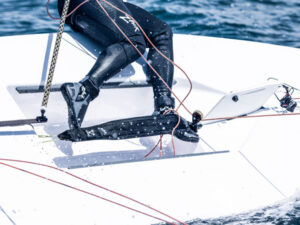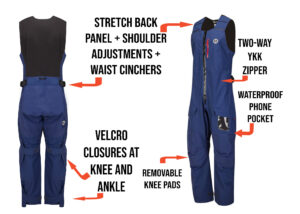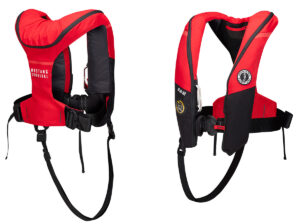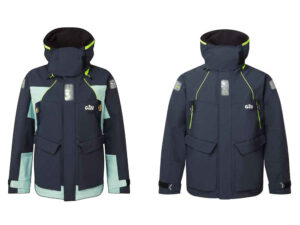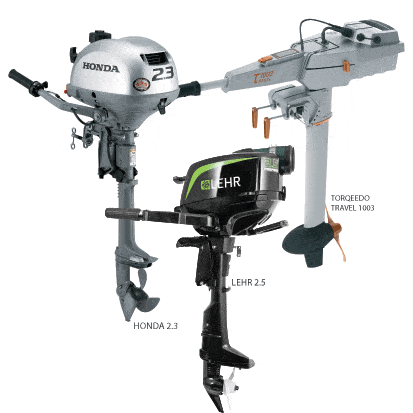
Outboard Options
In the early days of the outboard they were usually relegated to the murky confines of the bilge to wash around in squalor with halyard tails, old candy bars, and spent duct tape rolls. They were two-horses strong, four tops, and when called for duty these two-stroke dandies took dozens of pulls to get started. Once lit, they spewed all matter of what-not into the air and sea until they warmed up and got to work. There was one gear, so when journey’s end arrived it was the last tactic of the day to decide when to pull the choke and shut her down for the coast to the dock or mooring. But as hulls and sails have progressed, so too has the lowly outboard engine, which has morphed into a piece of technology worthy of its own custom-made, water-resistant storage bag. Today you can’t buy a new two-stroke in the United States, and now you even have your choice of fuel: gasoline, electricity, or propane.
Smarter gas engines
Any of the gasoline engines available today will do the trick for your small raceboat, and most have the preferred option for an on-engine gas tank, so we’ll continue generically. A few specifications to note when you’re doing your outboard search are overall weight, fuel capacity, ability to connect to a remote tank for longer trips to and from the racecourse, and shaft length. A 20-inch shaft length is appropriate for most sportboats; a 15-inch shaft will suffice for smaller boats.
The transition from two-stroke to four-stroke has resulted in engines that are quieter, cleaner running, and more reliable, but also a bit heavier, unfortunately. With four-strokes, there’s no pre-mixing of oil and gas, and that alone is worth upgrading to a new engine if you remain burdened with an old-tech two-stroke. Two other useful, though less-recent, improvements include having the throttle on the tiller arm and a neutral gear. Most of these units do not have reverse gears, but they can be turned around for reverse when necessary. The horsepower range recommended for 20-foot sportboats is 2.5 to 3 horsepower.
Electric has arrived
The Torqeedo company was launched in Germany in 2005 with an electric outboard motor the designers and engineers were convinced would be revolutionary. Having won a handful of industry awards lately, it would seem that the Torqeedo concept has been universally accepted, but only in the last year have we begun to see greater penetration into the sailing and small-boat racing market. With the Torqeedo Travel 1003 the company has introduced an engine that is appropriate for lightweight sportboats used primarily for inshore races where transit times are short. The 1003, with more battery capacity than earlier models, and 3 horsepower equivalency, communicates with the user both visually and audibly. As the battery depletes, the 1003 sounds a simple alarm when 30 percent, 20 percent, and 10 percent of the charge remains.
The technology of the Travel 1003 shines, however, when you look at the LCD screen housed in the tiller arm. This small display shows distance remaining at current speed, actual speed over ground, charge percentage remaining, and power consumption, all from a built in GPS and microchip working in concert. When you adjust the speed the 1003 recalculates and gives you updated information. This is crucial, as speed is a power kill. For example, according to Torqeedo’s numbers, reducing from full to half throttle increases the run time by a factor of seven or so, while decreasing the speed by a little less than half. If you have a long way to go, taking it easy will get you there.
The Travel 1003 breaks down easily into three parts: the battery pack, the tiller, and the aluminum leg. The motor itself is housed in a pod at the bottom of the leg, linked directly to the highly engineered, composite, three-blade propeller. The battery weighs just under 10 pounds with the tiller and leg coming in at just over 19 pounds together. This makes for a package that is very easy to carry in two parts and easy to mount. For easiest installation, mount the leg/tiller combination to the bracket, then install the battery and lock them together with the provided pin. Attach two wires to the battery, one from the tiller and one from the leg, with their waterproof connections, confirm that the magnetic kill switch is in place, twist the throttle, and go—in forward or reverse—with nearly silent thrust.
In practical use the Travel 1003’s battery will rarely be depleted completely while on the water, but if it is, give yourself nearly 15 hours to charge it to 100 percent with the provided charger. Torqeedo’s flexible 45-watt solar panel in the summer sunlight of North America and Europe will charge the battery in approximately 13 hours. The solar panel, when brought on board and plugged into the battery while the motor is running, will dramatically increase run times, even make them limitless at appropriate speed. The 1003’s brain calculates the solar panel’s input into the run time equation and keeps you up-to-date on the LCD Panel.
“With the extra battery, the run time for a Travel 1003 is more than 40 minutes at full throttle, which is comparable to a 2.3 Honda with its integral tank and an extra gallon of gas in the jerry can,” says Torqeedo representative Brandon Flack. “Using a Torqeedo eliminates the negatives of a gas engine, and introduces the positives of electric power. The attraction is the simplicity. No gas, no oil, no spills, no mess in the bilge, and virtually no maintenance.”
The latest version of the Travel 1003 is truly tuned to the water environment. Maintenance is simply a rinse with freshwater at the end of the day if available, and for hot climates, battery storage is better in a cool place rather than in boat when it’s not in use. The Travel 1003, when put together or in components, is waterproof to three feet—drop it in, pull it up, and twist the throttle, a very nice feature in our world.
Powered by propane
Introduced in 2012, LEHR’s outboard engines are gas combustion—with a propane twist. Propane is used in many engines, from lawn equipment to trucks and buses. LEHR’s engines are designed to work with either the ubiquitous one-pound green disposable canisters more commonly found lighting camp stoves and portable barbecues, or the 20-pound bottles that fuel your big grill. You don’t want to be lugging around the big bottle, though, so for sportboats, the 2.5 horsepower LEHR, using one-pound canisters is the way to go.
“Propane has a higher energy density than gasoline,” says Bernardo Herzer, founder and CEO of LEHR, who patented his technology for converting small engines from running on gasoline to using propane for fuel. “Propane is a better lubricant, and the engine does not need to be choked to get started. Simply pull the cord and you’re off.”
The 2.5 horsepower engine runs for approximately 2.5 hours at three-quarter throttle, says Herzer. And, although it’s not zero emissions, it emits 60 percent less carbon dioxide than gas engines, and emits no other chemicals. “Propane is not a marine pollutant, and at room temperature it evaporates,” says Herzer. “Also, there is zero contribution to ozone depletion from propane engines, no volatile organic compounds.”
The 2.5 horsepower outboard has forward and neutral gears, and can spin around for reverse, like its gas counterparts. The fuel source is easily found and self-contained, so adding fuel is a matter of unscrewing one canister and screwing in another.
Whatever means you choose to power your boat to and from the racecourse, today’s outboards are outstanding in their diversity and their individual strengths. Your needs and circumstances will guide you to the correct choice. Happy motoring . . . when you absolutely can’t sail.

